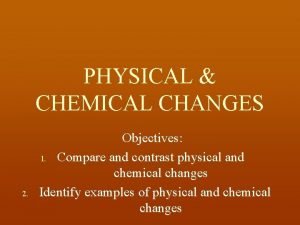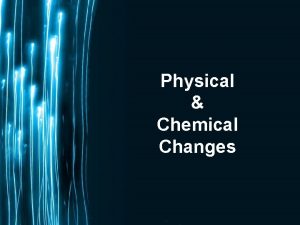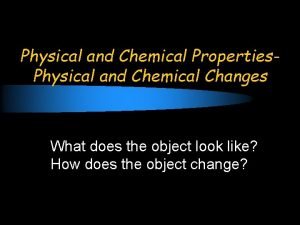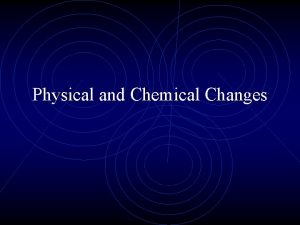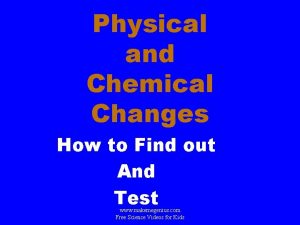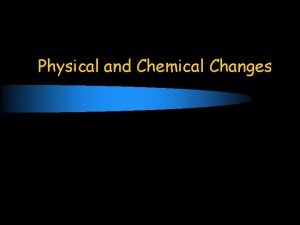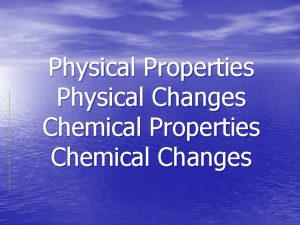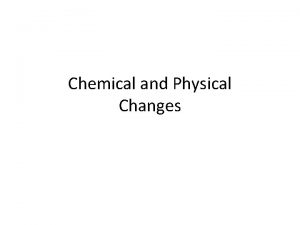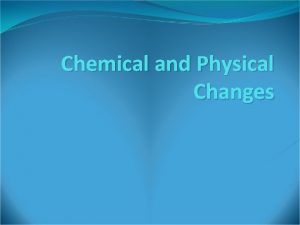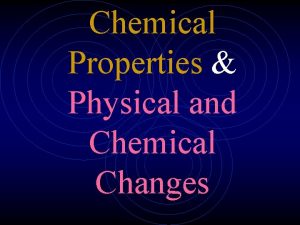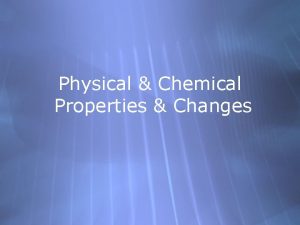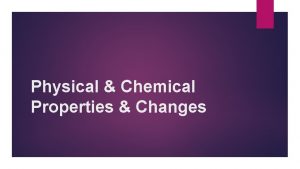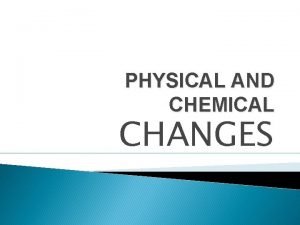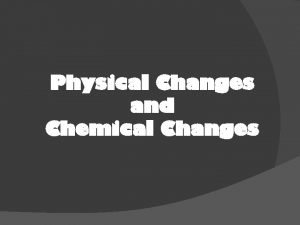Properties and Changes Physical vs Chemical Physical Properties











- Slides: 11

Properties and Changes Physical vs. Chemical

Physical Properties • Characteristic properties • Can be determined without changing substance’s chemical makeup • Examples ▫ ▫ ▫ Color Density Odor Solubility Texture

Physical Properties • Properties used to describe matter can be classified as extensive or intensive properties. • An extensive property is a property that depends on the amount of matter in a sample ▫ Ex. : mass, volume, density • An intensive property is a property that depends on the type of matter in a sample, not the amount of matter. • Ex. : color, odor, absorbancy

Chemical Properties • Play important roles in determining substances’ usefulness • Relate to the potential of a substance to undergo chemical changes • Examples: ▫ heat of combustion ▫ reactivity with water ▫ p. H

Physical Changes • Changes where the identity of the substance stays the same • Examples: ▫ ▫ Melting Boiling Bending Cutting

Chemical Changes • Transform substances into new substances • Examples of signs of chemical change: ▫ ▫ Rusting Gas formation Temperature change Color change

Classify each statement • Physical or chemical property? ▫ Pure metals have high luster (shiny, reflect light) ▫ Surfaces of some metals become dull when exposed to air ▫ Milk turns sour if left too long at room temperature ▫ Diamonds are hard enough to be used on drill bits ▫ Metals can be drawn into wires (ductile) ▫ Bread dough increases in volume if it is allowed “rise” ▫ Metals are better conductors of heat & electricity than nonmetals

Classify each statement • Physical or chemical property? ▫ Pure metals have high luster (shiny, reflect light) P ▫ Surfaces of some metals become dull when exposed to air C ▫ Milk turns sour if left too long at room temperature C ▫ Diamonds are hard enough to be used on drill bits P ▫ Metals can be drawn into wires (ductile) P ▫ Bread dough increases in volume if it is allowed “rise” C ▫ Metals are better conductors of heat & electricity than nonmetals P

Matter • Anything that has mass • Composed of atoms • 4 phases / states ▫ ▫ Solid Liquid Gas Plasma

Phases / States of Matter • Solid ▫ Fixed volume ▫ Fixed shape • Gas ▫ Takes volume of container ▫ Takes shape of container • Liquid ▫ Fixed volume ▫ Takes shape of container • Plasma ▫ Like superheated gas �Ex. : sun § Made of free electrons and ions

Standards • NGSSS ▫ SC. 912. P. 8. 2 Differentiate between physical and chemical properties and physical and chemical changes of matter. ▫ SC. 912. P. 8. 5 Relate properties of atoms and their position in the periodic table to the arrangement of their electrons.
 Physical change chemistry
Physical change chemistry Physical/chemical changes & properties color by number
Physical/chemical changes & properties color by number Physical and chemical properties
Physical and chemical properties Compare and contrast chemical and physical changes
Compare and contrast chemical and physical changes Chemical properties and changes lesson 4
Chemical properties and changes lesson 4 Section 1 chemical changes
Section 1 chemical changes Physical change
Physical change Physical and chemical changes
Physical and chemical changes Is sawing wood a chemical change
Is sawing wood a chemical change Generation genius physical and chemical changes
Generation genius physical and chemical changes Wadding up paper physical or chemical change
Wadding up paper physical or chemical change Physical change and chemical change
Physical change and chemical change



